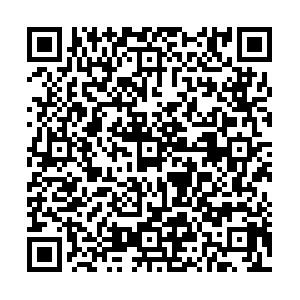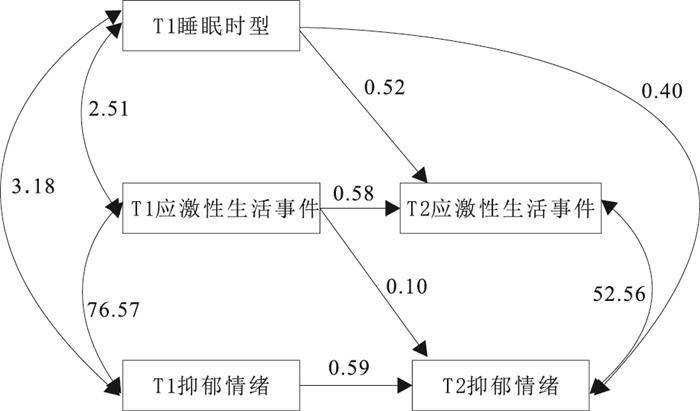Mediating role of stressful life events between sleep chronotype and depressive mood in adolescents
-
摘要:
目的 使用纵向中介模型探究应激性生活事件作为中介变量时,睡眠时型与抑郁情绪之间的内在关联机制,为预防青少年抑郁情绪提供参考依据。 方法 在2022年3月(T1)和10月(T2),以慕尼黑睡眠时型问卷(MCTQ)、青少年生活事件量表(ASLEC)和流调中心用抑郁量表(CES-D)为调查工具,对四川眉山某中学的初一、初二年级1 251名中学生进行追踪研究,共收集到2个时点的睡眠时型、应激性生活事件、抑郁情绪数据。 结果 在T1时青少年抑郁情绪检出率为22.5%,在T2时抑郁情绪检出率为27.0%;在同一时间点,睡眠时型、应激性生活事件以及抑郁情绪之间均呈正相关(r=0.06~0.69,P值均 < 0.05)。交叉滞后模型结果显示,早期的睡眠时型可以预测后期的抑郁情绪(β=0.53,P < 0.05),早期的抑郁情绪也能够显著预测后期的睡眠时型(β=0.01,P < 0.01);纵向中介模型分析表明,T1睡眠时型不仅可以直接影响T2抑郁情绪(直接效应值为1.421,95%CI=0.985~1.858),还可以通过T2应激性生活事件的中介作用影响T2抑郁情绪(间接效应值为1.268,95%CI=0.810~1.726)(P值均 < 0.05);尽管T1抑郁情绪可以直接预测T2睡眠时型(直接效应值为0.025,95%CI=0.017~0.032,P < 0.05),但不能够通过T2应激性生活事件的部分中介作用预测T2睡眠时型(间接效应值为-0.001,95%CI=-0.006~0.004,P>0.05)。 结论 睡眠时型不仅可以直接纵向预测青少年的抑郁情绪,同时也能通过应激性生活事件的纵向中介作用间接影响青少年的抑郁情绪。青少年应养成早睡早起的生活习惯,并提高对应激性生活事件的应对能力,降低抑郁情绪的发生,提高心理健康水平。 Abstract:Objective A longitudinal mediating model was designed to explore the relationship between sleep chronotype and depressive mood with stressful life events as the mediating variable, so as to provide reference basis for preventing depression in adolescents. Methods From March (T1) to October (T2) 2022, the Munich Chronotype Questionnaire, and Adolescent Self-rating Life Events Checklist and Center for Epidemiologic Studies Depression Scale were administered in 1 251 middle school students in the first and second grades of a middle school in Meishan, Sichuan Province for a follow-up study. Two wave of date on sleep time type, stressful life events, and depressive moods were collected. Results At T1, the detection rate of depressive mood was 22.5% in adolescents but 27.0% at T2.At the same time point, there were significant positive correlations between chronotype, stressful life events and depressive mood (r=0.06-0.69, P < 0.05). Cross-lagged model results showed that early sleep chronotype could significantly predict later depressive mood (β=0.53, P < 0.05), and early depressive mood could significantly predict later sleep chronotype (β=0.01, P < 0.01). Longitudinal mediation model analysis showed that T1 sleep chronotype not only directly affected T2 depressive mood (direct effect value=1.421, 95%CI=0.985-1.858, P < 0.01), but also affect T2 depressive mood through the partial mediating effects of T2 stressful life events (indirect effect value=1.268, 95%CI=0.810-1.726, P < 0.05). Although T1 depressive mood was a direct predictor of T2 sleep chronotype (direct effect value=0.025, 95%CI=0.017-0.032), it was not a direct predictor of T2 sleep chronotype by partial intermediate action of T2 stressful life events (indirect effect value=-0.001, 95%CI=-0.006-0.004, P>0.05). Conclusions Sleep chronotype can not only directly predict depressive mood of adolescents, but also indirectly affect depressive mood of adolescents through the longitudinal mediating effect of stressful life events. To prevent depression and improve mental health in this population, adolescents should develop the habit of early sleep schedule, and improve their ability to cope with stressful life events. -
Key words:
- Stress, psychological /
- Sleep /
- Depression /
- Mental health /
- Adolescent
1) 利益冲突声明 所有作者声明无利益冲突。 -
表 1 青少年睡眠时型、应激性生活事件以及抑郁情绪得分间相关性分析(n=1 251, r值)
Table 1. Related analysis between sleep chronotype, ASLEC score and CES-D score among adolescents(n=1 251, r)
变量 T1睡眠时型 T2睡眠时型 T1应激性生活事件 T2应激性生活事件 T1抑郁情绪 T2睡眠时型 0.34** T1应激性生活事件 0.23** 0.11** T2应激性生活事件 0.18** 0.06* 0.52** T1抑郁情绪 0.32** 0.19** 0.68** 0.43** T2抑郁情绪 0.25** 0.19** 0.49** 0.69** 0.64** 注:*P<0.05,**P<0.01。 -
[1] 蒋索, 丁金琦, 刘艳, 等. 青少年早期网络欺凌/受欺凌对睡眠质量的影响: 社交焦虑和抑郁情绪的链式中介作用[J]. 心理发展与教育, 2023, 39(1): 85-96. https://www.cnki.com.cn/Article/CJFDTOTAL-XLFZ202301010.htmJIANG S, DING J Q, LIU Y, et al. The effect of cyber-bullying/cyber-victimization on sleep quality in early adolescence: a serial mediation model of social anxiety and depression mood[J]. Psychol Dev Educ, 2023, 39(1): 85-96. (in Chinese) https://www.cnki.com.cn/Article/CJFDTOTAL-XLFZ202301010.htm [2] DONG X X, LIANG G, LI D L, et al. Association between parental control and depressive symptoms among college freshmen in China: the chain mediating role of chronotype and sleep quality[J]. J Affect Disord, 2022, 317: 256-264. doi: 10.1016/j.jad.2022.08.091 [3] ANDRÉ C T, ALICIA C, REGINA L S, et al. How do stress, sleep quality, and chronotype associate with clinically significant depressive symptoms?A study of young male military recruits in compulsory service[J]. Brazil J Psychiatry, 2019, 42(1): 54-62. [4] 侯贵钟, 刘坤, 张爱华, 等. 重庆市男性大学生昼夜节律紊乱与抑郁症状的关联研究[J]. 中华疾病控制杂志, 2020, 24(4): 404-408, 488. https://www.cnki.com.cn/Article/CJFDTOTAL-JBKZ202004008.htmHOU G Z, LIU K, ZHANG A H, et al. Correlation between circadian disruption and depressive symptom in male undergraduates in Chongqing[J]. Chin J Dis Control, 2020, 24(4): 404-408, 488. (in Chinese) https://www.cnki.com.cn/Article/CJFDTOTAL-JBKZ202004008.htm [5] 李婷婷, 陶芳标, 伍晓艳. 青少年睡眠时型与抑郁症状相关性的系统评价[J]. 中国循证医学杂志, 2022, 22(11): 1319-1324. https://www.cnki.com.cn/Article/CJFDTOTAL-ZZXZ202211010.htmLI T T, TAO F B, WU X Y. Association between adolescent chronotype and depressive symptoms: a Meta-analysis[J]. Chin J Evid Based Med, 2022, 22(11): 1319-1324. (in Chinese) https://www.cnki.com.cn/Article/CJFDTOTAL-ZZXZ202211010.htm [6] OGINSKA H, MOJSA-KAJA J, MAIRESSE O. Chronotype description: in search of a solid subjective amplitude scale[J]. Chronobiol Int, 2017, 34(10): 1388-1400. doi: 10.1080/07420528.2017.1372469 [7] HARADEN D A, MULLIN B C, HANKIN B L. The relationship between depression and chronotype: a longitudinal assessment during childhood and adolescence[J]. Depress Anx, 2017, 34(10): 967-976. doi: 10.1002/da.22682 [8] DRUIVEN S J M, KNAPEN S E, PENNINX B W J H, et al. Can chronotype function as predictor of a persistent course of depressive and anxiety disorder[J]. J Affect Disord, 2018, 242: 159-164. [9] NORBURY R. Chronotype, depression and hippocampal volume: cross-sectional associations from the UK Biobank[J]. Chronobiol Int, 2019, 36(5): 709-716. doi: 10.1080/07420528.2019.1578229 [10] 黄秦, 郭佳坤, 彭惠子, 等. 青少年生活事件与焦虑的关系: 一个有调节的中介模型[J]. 中国健康心理学杂志, 2021, 29(12): 1892-1896. https://www.cnki.com.cn/Article/CJFDTOTAL-JKXL202112029.htmHUANG Q, GUO J K, PENG H Z, et al. Relationship between life events and anxiety in adolescents: a moderated mediation model[J]. Chin J Health Psychol, 2021, 29(12): 1892-1896. (in Chinese) https://www.cnki.com.cn/Article/CJFDTOTAL-JKXL202112029.htm [11] ACAR Ö F, ÖGVLMVÜŞ S, BOYSAN M, et al. Associations between circadian preferences, sleep quality, dissociation, post-traumatic cognitions, and post-traumatic stress disorder (PTSD) among incarcerated offenders[J]. Sleep Hypn, 2019, 21(3): 201-219. [12] GAO B C, ZHAO M X, FENG Z Z, et al. The chain mediating role of cognitive styles and alienation between life events and depressive mood among rural left-behind children in poor areas in Southwest China[J]. J Affect Disord, 2022, 306: 215-222. doi: 10.1016/j.jad.2022.03.040 [13] 陈卿. 睡眠行为、昼夜节律与男(雄)性精液参数的关联研究[D]. 重庆: 中国人民解放军陆军军医大学, 2016.CHEN Q. Association among sleep behaviors, circadian system and semen parameters in males[D]. Chongqing: Army Medical University, 2016. (in Chinese) [14] 刘贤臣, 刘连启, 杨杰, 等. 青少年生活事件量表的编制与信度效度测试[J]. 山东精神医学, 1997, 10(1): 15-19. https://www.cnki.com.cn/Article/CJFDTOTAL-SDJB199701004.htmLIU X C, LIU L Q, YANG J, et al. The development, reliability and validity of the Adolescent Life Events Scale[J]. Shandong Psychiatr Med, 1997, 10(1): 15-19. (in Chinese) https://www.cnki.com.cn/Article/CJFDTOTAL-SDJB199701004.htm [15] 辛秀红, 姚树桥. 青少年生活事件量表效度与信度的再评价及常模更新[J]. 中国心理卫生杂志, 2015, 29(5): 355-360. https://www.cnki.com.cn/Article/CJFDTOTAL-ZXWS201505012.htmXIN X H, YAO S Q. Validity and reliability of the adolescent self-rating life events checklist in middle school students[J]. Chin Ment Health J, 2015, 29(5): 355-360. (in Chinese) https://www.cnki.com.cn/Article/CJFDTOTAL-ZXWS201505012.htm [16] 章婕, 吴振云, 方格, 等. 流调中心抑郁量表全国城市常模的建立[J]. 中国心理卫生杂志, 2010, 24(2): 139-143. https://www.cnki.com.cn/Article/CJFDTOTAL-ZXWS201002019.htmZHANG J, WU Z Y, FANG G, et al. Development of the Chinese age norms of CES-D in urban area[J]. Chin J Ment Health, 2010, 24(2): 139-143. (in Chinese) https://www.cnki.com.cn/Article/CJFDTOTAL-ZXWS201002019.htm [17] 杨文辉, 熊戈. 常用抑郁量表筛查我国青少年抑郁的效度和划界分[J]. 中国临床心理学杂志, 2016, 24(6): 1010-1015. https://www.cnki.com.cn/Article/CJFDTOTAL-ZLCY201606011.htmYANG W H, XIONG G. Development of the Chinese age norms of CES-D in urban area[J]. Chin J Clin Psychol, 2016, 24(6): 1010-1015. (in Chinese) https://www.cnki.com.cn/Article/CJFDTOTAL-ZLCY201606011.htm [18] ILONA M, ERKKI K, MARKKU P, et al. Circadian preference links to depression in general adult population[J]. J Affect Disord, 2015, 188: 143-148. [19] 吕秋玥, 汤万杰, 王强, 等. 大学生昼夜节律类型与抑郁情绪相关性的纵向研究[J]. 重庆医科大学学报, 2021, 46(10): 1163-1169. https://www.cnki.com.cn/Article/CJFDTOTAL-ZQYK202110006.htmLYU Q Y, TANG W J, WANG Q, et al. A longitudinal study on the correlation between circadian rhythm and depression in college students[J]. J Chongqing Med Univ, 2021, 46(10): 1163-1169. (in Chinese) https://www.cnki.com.cn/Article/CJFDTOTAL-ZQYK202110006.htm [20] DIENER E D, SUCH E M, LUCAS R, et al. Subjective well-being: three decades of progresses[J]. Psychol Bull, 1999, 125(2): 276-302. [21] OATLEY K, KELTNER D, JENKINS J M. Emotions and mental health in childhood. Understanding emotions[M]. 2th ed. Oxford, UK: Blackwell Publishing, 2006: 321-383. [22] O'SULLIVAN E, GOGAN E, DOYLE L, et al. Decider life skills training as a method of promoting resilience with mental health student nurses on clinical placement[J]. Nur Educ Prac, 2021, 56: 103222. [23] MOHAMMADBEIGI A, ABSARI R, VALIZADEH F, et al. Sleep quality in medical students: the impact of over-use of mobile cell-phone and social networks[J]. J Res Health Sci, 2016, 16(1): 46-50. -







 下载:
下载:


